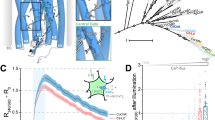Abstract
The isolation by Shimomura, Johnson and Saiga1 of a protein, aequorin, that emits light in the presence of micromolar concentrations of ionised calcium opened up new possibilities for the study of ionised calcium inside cells2–5. It is a relatively simple matter to introduce aequorin into large cells by microinjection, and the rate of light emission gives a direct measure of intracellular free calcium. During an investigation into the action of certain anaesthetics on squid axons, we noticed that these agents always increase the light output from intracellular aequorin. Subsequent analysis has now revealed that this does not result from a rise in ionised calcium inside the axon but seems to reflect a direct effect of the anaesthetic agent on the aequorin molecule. The agents studied all produce greater activation of the light emitting reaction at a constant level of ionised calcium. These rather simple observations have several important biological implications: (1) aequorin might be an interesting model system for studying interaction between anaesthetics and proteins, (2) other Ca-sensitive proteins might behave like aequorin, their affinity for calcium being subject to modulation, and (3) such modulation of endogenous Ca-binding proteins might contribute to the mechanism of anaesthesia.
This is a preview of subscription content, access via your institution
Access options
Subscribe to this journal
Receive 51 print issues and online access
$199.00 per year
only $3.90 per issue
Buy this article
- Purchase on Springer Link
- Instant access to full article PDF
Prices may be subject to local taxes which are calculated during checkout
Similar content being viewed by others
References
Shimomura, O., Johnson, F. H. & Saiga, Y. Science 140, 1339 (1963).
Ashley, C. C. & Ridgway, E. B. J. Physiol, Lond. 209, 105 (1970).
Baker, P. F., Hodgkin, A. L. & Ridgway, E. B. J. Physiol, Lond. 218, 709 (1971).
Rose, B. & Loewenstein, W. R. Nature 254, 250 (1975).
Blinks, J. R., Prendergast, F. G. & Allen, D. G. Pharmac. Rev. 28, 1 (1976).
Baker, P. F. & Honerjäger, P. Nature 273, 160 (1978).
Pichon, Y. J. Physiol, Lond. 287, 30P (1979).
Kamaya, H., Ueda, I., & Eyring, H. Proc. natn. Acad. Sci. U.S.A. 74, 5534 (1977).
Ebashi, S., Endo, M. & Ohtsuki, I. Q. Rev. Biophys. 2, 351 (1969).
Teo, T. S. & Wang, J. H. J. biol. Chem. 248, 5950 (1973).
Watterson, D. M., Harrelson, W. G., Keller, P. M., Sharief, F. & Vanaman, T. C. J. biol. Chem. 251, 450f (1976).
Jarrett, H. W. & Penniston, J. T. J. biol. Chem. 253, 4676 (1978).
Meech, R. W. SEB Symp. XXX, 161 (Cambridge University Press, 1976).
Ilundain, A. & Naftalin, R. J. Nature 279, 446 (1979).
Krnjevic, K. & Lisiewicz, A. J. Physiol, Lond. 225, 363 (1972).
Simons, T. J. B. J. Physiol, Lond. 300, 30P (1980).
Author information
Authors and Affiliations
Rights and permissions
About this article
Cite this article
Baker, P., Schapira, A. Anaesthetics increase light emission from aequorin at constant ionised calcium. Nature 284, 168–169 (1980). https://doi.org/10.1038/284168a0
Received:
Accepted:
Issue Date:
DOI: https://doi.org/10.1038/284168a0
This article is cited by
-
Molecular mechanisms of general anaesthesia
Nature (1982)
-
Free Ca2+ increases in exponential phases during mouse oocyte activation
Nature (1981)
Comments
By submitting a comment you agree to abide by our Terms and Community Guidelines. If you find something abusive or that does not comply with our terms or guidelines please flag it as inappropriate.



